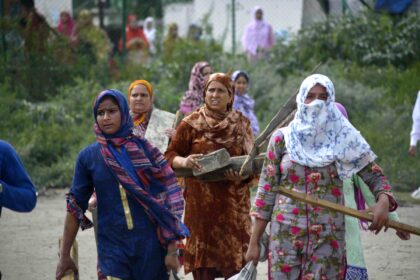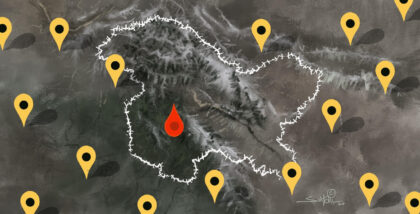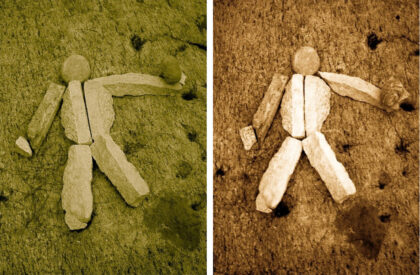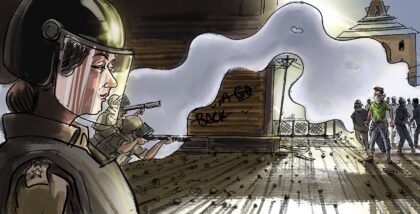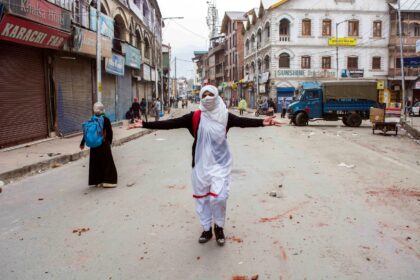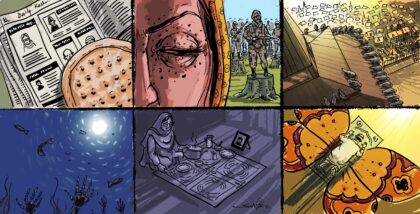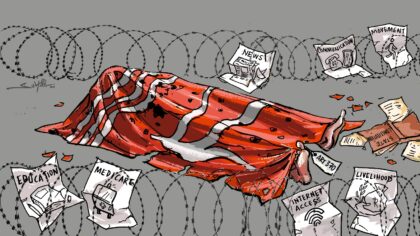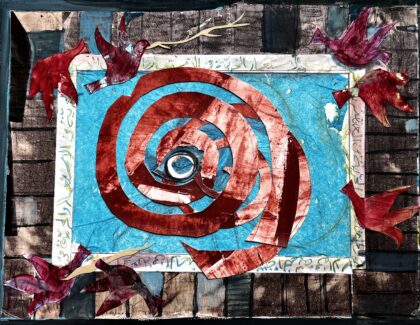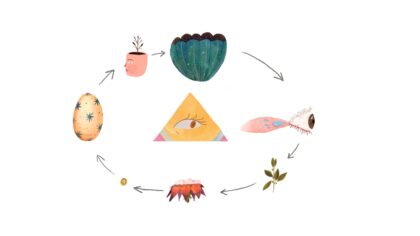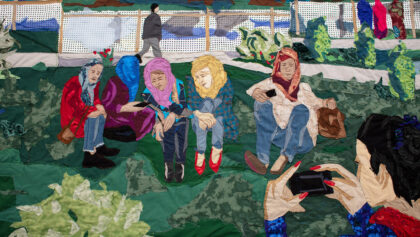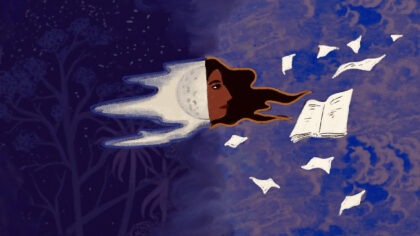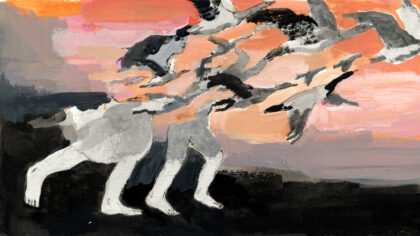 Crop from a map by J.G. Bartholomew, titled “North-West Frontier Provinence and Kashmir,” from the Imperial Gazetteer of India, 1907-1909.
Crop from a map by J.G. Bartholomew, titled “North-West Frontier Provinence and Kashmir,” from the Imperial Gazetteer of India, 1907-1909.
Kashmir emerged as an “international dispute” in 1947, but looking at the Kashmir question exclusively from that prism privileges India-Pakistan state-centric perspectives while erasing Kashmir’s own distinct political history. To begin to understand the Kashmiri aspiration for self-determination, it is important to trace the major events that have shaped Kashmiri political subjectivity. Kashmir’s political history is a complex and volatile interaction between external forces and internal struggles. Keeping this in mind, I present this timeline as a resource for those curious about what drives the Kashmiri movement for self-determination despite the tremendous odds it faces. To be clear, the timeline is not the history of Kashmir, but a chronicle of key political events. In being so, the timeline falls squarely within the long tradition of Kashmiri chronicle writing. I start with the year 1586 because many Kashmiris see the arrival of the Mughals as the first tragic entanglement of Kashmir with South Asia.
1586
Apart from the brief periods, when it was part of the Buddhist empires of Ashoka (~300 BC) and Kushans (~130 AD), Kashmir had remained more or less independent under a series of regional dynasties, including Hindu-Buddhist Karkotas and Muslim Shah-Miris. The centuries of complex interaction between indigenous peoples of Kashmir and Aryan settlers, and later preachers from South India, Central Asia and Iran, had led to mass conversions to Buddhism, Shaivism, and eventually Islam. In 1586, Mughal Emperor Akbar attempts a conquest of Kashmir, but is thwarted by the last native Kashmiri Muslim ruler, Yusuf Shah Chak. Under the pretext of negotiations, Akbar takes Chak as a prisoner and makes Kashmir a part of his Afghan principality. Never allowed to return to Kashmir, Chak’s grave is in present-day Indian state of Bihar.
1750s-1846
As the Mughal empire weakens, Kashmir first falls under the Afghans and then under the Sikhs from Lahore.
1846
In the aftermath of Anglo-Sikh wars in the 1840s, the British East India Company rewards a Dogra chieftain, Gulab, who had betrayed his Sikh overlords during the war, with control over Kashmir. Signed on 9 March 1846, the Treaty of Amritsar allows Gulab to claim the title of Maharaja of the state of Jammu and Kashmir, which now includes the kingdom of Ladakh that had been incorporated into the previous Sikh empire in 1834. In return, Gulab agrees to serve British interests as a buffer state (primarily against the Tsarist Russia) and send Kashmiri soldiers to join British campaigns as and when called upon. A brief rebellion against the treaty by the Sikh-appointed Muslim governor of Kashmir Imam-ud-Din is suppressed. Despite most of their subjects being Muslim, Dogras turn the state into a Hindu kingdom. Except for the period from 1889 and 1905, when the British curtailed some Dogra powers, the Dogra maharajas enjoyed almost full sovereignty over Kashmir. Dogra rule is marked by oppression, forced labor, and heavy taxation. Several artisans’ revolts have been forcibly put down. In particular, the Kashmiri Muslims, who form the majority of the state’s subjects, are systematically impoverished, disempowered and exploited, while the minority upper-caste Hindus become part of the ruling establishment.
1931
On July 13, during the trial of Abdul Qadeer, who is accused of inciting Kashmiris to rebel against the Dogras, people assemble in the capital Srinagar. The Dogra troops shoot 22 Kashmiris dead. Widespread protests erupt all over the country against Maharaja Hari Singh, but the revolt is brutally suppressed. Dozens of Kashmiris are shot dead during the next few days in Islamabad (Anantnag) and Kupwara. In the hilly regions of Poonch, a rebellion erupts which will continue for years.
1932
Kashmiri Muslim leaders petition the British and the Dogra rulers for reforms. Several of them launch the All Jammu Kashmir Muslim Conference (MC) with a goal to fight for governmental reform, education, and representation for Kashmiri Muslims in the government. The Maharaja’s subsequent efforts to redress the grievances, including establishing Praja Sabha (“Subjects’ Assembly”) turn out to be empty as Muslim representation remains disproportionately minimal. A group of radical Kashmiri youth led by Sheikh Abdullah emerges as a popular faction within the Muslim Conference.
1939
MC splits over political approach. Sheikh Abdullah names the major faction the Jammu Kashmir National Conference (JKNC or NC), signaling that their goal is a secular independent state and an end to feudalism. NC mobilizes Kashmiri peasantry.
1940s
Several small new Kashmiri parties emerge, including the Worker-Peasant Party. Some socialist and communist organizations also begin to grow. NC grows in popularity for its defiance of the Dogras, while Chaudhary Ghulam Abbas revives the old Muslim Conference and builds significant support among the Muslims of the Jammu province.
1944
NC adopts the “New Kashmir Resolution,” proposing radical socio-economic transformation, the end of monarchy and feudalism, turning Kashmir into a democratic republic, and granting full citizenship rights to all the people of Jammu and Kashmir.
1945
With older roots in Islamist social reform, Jamaat Islami holds its first convention in Kashmir. Influenced by its parent body in British India, which opposed the creation of Pakistan, Jamaat Islami in Kashmir takes a stand against both NC’s secular nationalism and MC’s Muslim nationalism.
1946
NC launches “Quit Kashmir” movement and MC starts a campaign of action; both are against the monarchy. Sheikh Abdullah and Chaudhary Ghulam Abbas are arrested. Over the years, Abdullah has grown closer to Indian Congress leaders and is opposed to Jinnah’s Muslim League. Yet, he agrees Kashmir should remain its own entity. The Muslim Conference leans toward Jinnah.
1947
Between August and October, Kashmir is independent. With Pakistan now a reality, Jamaat Islami activists want Kashmir to join Pakistan if it becomes an Islamic state, yet their parent body in British India has opposed Jinnah. Muslim Conference passes a resolution to join Pakistan. The Socialist Party also wants to join Pakistan. But NC is opposed to the idea. The British withdrawal and the partition of British India into India and Pakistan leads to violence in Bengal, Delhi, Punjab and elsewhere. Kashmiris have been fighting against the monarchy and don’t see their struggle as part of South Asian secular, Hindu, or Muslim nationalisms, but the British ask “Princely Rulers” to accede either to India or to Pakistan based on geographical contiguity and religious demography. According to this Partition logic, Kashmir should have gone to Pakistan, as the state has a close to 77 percent Muslim population. In September and October 1947, Hindu militias and Dogra troops attack Jammu’s Muslims, killing tens of thousands. In Poonch, along the border with newly-created Pakistan, rebels create an independent state called “Azad (Free) Jammu Kashmir (AJK).” As ethnic cleansing of Jammu Muslims continues, many flee to AJK and to Pakistan. Much of Muslim Conference leadership and members are displaced. According to census reports from the time and later research, upwards of 200,000 Muslims are dead and an equal number become refugees. After what will come to be known as the “Jammu Massacre,” Jammu becomes a Hindu-majority city. Meanwhile, the Dogras lose control of Gilgit Baltistan province in the north. With their leader, Sheikh Abdullah, in prison, NC remains dormant. In September, troops from the neighboring state of Patiala and Hindu nationalist paramilitaries of the RSS arrive to bolster the Dogras. Pakistan blocks supplies into Kashmir. Indian Congress leaders put pressure on the Dogras to accede to India and release Abdullah. The Dogra maharaja wants to remain independent and has signed a Standstill Agreement with Pakistan, but India has refused to sign. As rebellion continues along the borders, on October 22, 1947, members of Afridi and other Pashtun groups begin to converge along the border and enter Baramulla to aid Kashmiris but falter without any clear leadership. The Maharaja flees the Kashmir valley and asks India for help. Indians demand he sign the Treaty of Accession and give power over Kashmir’s defense, foreign affairs, and communication to India. Abdullah is made Emergency Administrator and he sees Pashtuns as a threat. On October 26, Indian troops arrive in Srinagar and the next day Maharaja signs the treaty. Indian invasion pulls Pakistani troops in too. The first India-Pakistan war over Kashmir breaks out. On November 21, Nehru says: “I have repeatedly stated that as soon as peace and order have been established; Kashmir should decide about accession by plebiscite or referendum under international auspices such as those of United Nations.”
1948
By the middle of the year, the war has entered a stalemate. India takes the case of Kashmir to the United Nations. Kashmir is officially recognized as a disputed territory. The United Nations Security Council passes a resolution (UNSC Resolution 47) providing for 1. Ceasefire, 2. Withdrawal of Pakistani and Indian troops, and 3. Plebiscite in Kashmir (under international supervision with minimal Indian military presence). UN Commission on India and Pakistan (UNCIP) is created.
1949
Ceasefire is proclaimed under the UN auspices. India is in control of two-thirds of the historic Kashmir state while Pakistan has control over one-third, including the AJK.
1950
India backtracks on its promise of the plebiscite, even though Nehru would continue to make statements about India’s pledge to Kashmiris until 1959. Indian Constitution comes into effect and Article 1 proclaims the entire state of J&K as a part of the territory of India. Article 370 gives a “special” status to the State of J&K, more or less corresponding to the terms of the Instrument of Accession. Pro-Pakistan Kashmiri leaders are arrested, and many are sent into exile.
1951
Elections are held in the state. The UNSC passes a resolution (UNSC Resolution 91) saying elections will not be a substitute for the plebiscite. Sheikh Abdullah wins the elections, mostly unopposed, and becomes the Prime Minister. Abdullah carries out land reforms and adopts measures such as debt relief. The Jammu Kashmir Constituent Assembly is created to draft the constitution for the state. In India, Hindu nationalists begin agitation over giving special status to Kashmir. They demand “one country, one constitution, one flag.”
1952
Land reforms, while benefitting impoverished Kashmiri Muslims and under-caste Hindus, lead to resentment among erstwhile members of Dogra royalty and Hindu feudals, who assemble under the aegis of a Hindu nationalist party, Praja Parishad. Abdullah sees them as a threat but is unable to control their influence. He begins to shift positions between endorsing Kashmir’s accession to India and supporting the right of self-determination for Kashmiris. He signs the Delhi Agreement, but does not confirm the accession of Kashmir to India. The Delhi Agreement says: 1. except in three matters listed under Instrument of Accession, sovereignty will reside in Jammu and Kashmir; 2. Kashmiris will be citizens of India, but the elected Kashmir government will decide permanent residency requirements in the state; 3. Kashmir will have its own flag and constitution; 4. Kashmir will have a Prime Minister (wazir azam) and President (sadr-e-riyasat). Jamaat Islami separates from its parent body in India.
1953
As Hindu nationalist groups coalesce against Abdullah, the Indian government claims he is conspiring with the Chinese, the Arabs, and the Americans to create an independent Kashmir. In August, Abdullah is arrested (he will spend the next decade in prison). One of his aides and the deputy prime minister until then, G.M. Bakshi, is installed as the Prime Minister. Abdullah’s loyalists are removed from the government and the NC.
1954
Bakshi gets the accession formally ratified in 1954. India passes a “Presidential Order” using Article 370 which effectively gives the Indian parliament many more powers than were part of the Instrument of Accession and the Delhi Agreement. This is the start of the “erosion of autonomy,” which will continue in the years to come. All dissent in Kashmir is crushed.
1955
Afzal Beg, a lieutenant of Abdullah’s, forms the Plebiscite Front, which becomes the principal opposition to the governments led by India-loyalist Bakshi and his successors.
1956
The J&K Constituent Assembly adopts a new constitution, declaring the state an integral part of the Indian Union. Kashmiri activists, including those from Plebiscite Front, reject the declaration, and continue to insist on the promised self-determination.
1957
The UN passes another resolution (UNSC Resolution 122) affirming that only the “will of the people expressed through the democratic method of a free and impartial plebiscite conducted under the auspices of the United Nations” will determine Kashmir’s final status, and states that the J&K Constituent Assembly’s actions, including administrative or legal changes, are invalid and would not constitute a final disposition of the state.
1962
India and China fight a war. India loses control over large tracts of land in Ladakh, especially Aksai Chin, that had been part of the State of Jammu and Kashmir.
1963
A holy relic—believed to be a strand of hair from the Prophet’s beard—is found missing from the Hazratbal shrine in Srinagar. Popular agitation erupts across Kashmir Valley and continues until the relic is mysteriously recovered in January 1964. Protests expand against extension of Indian powers to Kashmir including Indian president’s power to dismiss Kashmiri governments.
1965
Second India-Pakistan war breaks out after Pakistan sends infiltrators across the ceasefire line in August. The war ends in a ceasefire on September 23. The status quo remains. India removes the title of Prime Minister and Sadr e Riyasat from its loyalist Kashmiri officials, instead using the term Chief Minister.
1966
Small Kashmiri armed revolutionary groups emerge, some in the shadow of the Plebiscite Front. These groups call for complete independence of Jammu and Kashmir. One of these groups is Jammu Kashmir National Liberation Front (JKNLF) created by Maqbool Bhat and others. Another is Al Fatah, which builds a strong underground network. Most are arrested and will spend years in prison.
1971
India and Pakistan fight a war, resulting in the secession of East Pakistan and the formation of Bangladesh.
1972
India and Pakistan sign the Shimla Agreement, which recognizes the ceasefire line of 1949 as the Line of Control (LoC). The Shimla Agreement includes a clause stating that the final settlement of Kashmir will be decided bilaterally. Kashmiris see themselves as being further sidelined in future negotiations over their own country.
1974
Sheikh Abdullah is allowed to return to Kashmir. Many Kashmiris welcome him. But on Indira Gandhi’s insistence, he disbands the Plebiscite Front. Abdullah agrees to give up the demand for self-determination.
1975
Abdullah accepts the much diminished position of Chief Minister. In June, Prime Minister Indira Gandhi plunges India into an Emergency. Abdullah supports her and does not oppose when the Emergency is extended to Kashmir ten days later. Abdullah and his aide Beg win by-elections, but Syed Ali Geelani, who is a Jamaat Islami legislator, claims election rigging. Abdullah bans Jamaat Islami and closes down dozens of its schools across Kashmir. Revolutionary armed groups that had risen in the shadow of the Plebiscite Front are in a disarray, even though Abdullah drops long-standing cases against Al Fatah members.
1976
Maqbool Bhat, having spent years in Indian and Pakistani jails (in Pakistan, for being suspected as an Indian spy), is arrested again in Kashmir, where a death warrant has earlier been issued against him for the murder of a bank official at the hands of one of his associates.
1977
On May 29, 1977 Amanullah Khan, Abdul Khaliq Ansari and few others from the Azad Kashmiri diaspora in Britain form the Jammu Kashmir Liberation Front (JKLF) in Birmingham. Maqbool Bhat is proclaimed to have joined the new organization. Sheikh Abdullah wins elections in 1977. With the Indian establishment’s backing, the opposition to his NC is decimated. The old Jamaat Islami, having contested the elections since 1971, wins only one seat in the Assembly.
1979
Iran’s Islamic revolution and the execution of Pakistan’s former Prime Minister, Z.A. Bhutto, on the orders of General Zia ul Haq, causes widespread ripples across Kashmir. Jamaat Islami members, seen as supporters of General Zia, are attacked by NC cadres as well as by some Islamic preachers in the countryside, especially in Islamabad (Anantnag) where Jamaat Islami’s support among the salaried classes is growing.
1982
On September 8, Sheikh Abdullah dies.
1983
Massive election rigging creates dissensions within NC and conflicts begin among Abdullah’s heirs. Indian PM Indira Gandhi, campaigning in Jammu, ignites Hindu passions against Kashmiri Muslims.
1984
On February 11, Maqbool Bhat is hanged in Tihar Jail. Indian authorities refuse to return his body to his family. Small groups of Kashmiris cross the LoC to plan armed movement and return to form underground cells. In April, the Indian Army captures the Siachen Glacier region of Kashmir from Pakistan. In June, the Indian military’s assault on the Golden Temple, the spiritual center of Sikhs in Amritsar, leaves hundreds of Sikhs dead. Many Sikh activists cross the Punjab border into Pakistan to get arms training. In July, the Indian governor in Kashmir openly interferes in Kashmiri politics. Farooq, Abdullah’s son and heir, is dismissed as the Chief Minister and his opponent in the NC and brother-in-law, Ghulam Muhammad Shah, is installed in his place. Small new Islamist groups begin to emerge in Kashmir, mostly led by Kashmir University students. In October, Indira Gandhi is shot dead by her bodyguards.
1986
Mujahideen war against the Soviets in Afghanistan is at its peak. India loyalist and Farooq Abdullah’s brother in law, Ghulam Muhammad Shah, is dismissed as Chief Minister, after Farooq gives assurances to Indian PM Rajiv Gandhi that he will crack down on the growing unrest in Kashmir. Farooq forms a coalition government with the Indian National Congress in Kashmir.
1987
A number of opposition parties join to form an alliance against the NC. They are called the Muslim United Front (MUF). There is blatant poll rigging. Young polling agents of MUF, among them Yasin Malik, are arrested and tortured. Farooq Abdullah is allowed to win the elections and becomes Chief Minister. The MUF wins only four seats—despite a clear wave of support for the party—including one by Syed Ali Geelani of the Jamaat Islami and Qazi Nisar, the Mirwaiz (head preacher) of South Kashmir. MUF contestants, like Yusuf Shah, are arrested.
1988
Repression in Kashmir increases. Protestors demanding basic things, like electricity, are shot down. Several groups of young Kashmiri men, including Hamid Sheikh, Ashfaq Wani, Javaid Mir, and Yasin Malik (now out of jail), cross the LoC for arms training. Later known as the HAJY group (acronym of the first letters of their names), they join the JKLF. Busy fighting the Soviets in Afghanistan, Pakistan however sends them back without promises. Pakistan cuts even minimal support as General Zia dies in a crash and Benazir Bhutto becomes the prime minister, who invites Indian PM Rajiv Gandhi to Pakistan. JKLF declare armed struggle against India, exploding several small bombs in Srinagar. Jamaat Islami opposes armed struggle in its publication Azan and insists on the 1985 amendment to its party constitution that calls for resolution through constitutional means and dialogue.
1989
The judge who had sentenced Maqbool Bhat to death is shot dead. Indian operations to capture JKLF members become intense. Hamid Sheikh has been captured. In November and December, JKLF successfully uses a high-profile kidnapping to negotiate the release of their members, including Sheikh. Vast crowds of Kashmiris come out in support of JKLF and to welcome the rebels. With Soviet withdrawal from Afghanistan, Pakistan turns attention to Kashmir, but seems interested in creating its own group, one that could profess a pro-Pakistan ideology. Among several such groups, Hizbul Mujahideen (HM) is founded by a Jamaat Islami activist and schoolteacher known as Master Ahsan Dar. Yusuf Shah, also from Jamaat Islami, joins the HM and uses the nom de guerre Syed Salahuddin.
1990
Indian military forces carry out several massacres across Kashmir in January. Protests intensify, and thousands of Kashmiris publicly resign from pro-India parties. The four MUF legislators resign have resigned as well. On January 17, India dismisses Farooq Abdullah’s government and imposes central rule. A Hindu nationalist bureaucrat, Jagmohan, is installed as the governor. He claims that “Kashmir is sick, and I am its nursing orderly,” and ominously threatens Kashmiris. Jagmohan swiftly launches widespread military crackdowns on urban neighborhoods. Intense curfews are imposed. Armed groups carry out assassinations of government officials, NC activists, and intelligence agents. While many of these (~200) are Kashmiri Muslim, a significant number (~70) are Kashmiri Hindus, who have held top positions in the government and constitute three percent of the population. Thousands of Hindu families leave Kashmir on January 19 and head to Jammu in the south. (Years later, many Hindus would claim they left because they were afraid for their lives and that militant groups had threatened them, while many Kashmiri Muslims would blame Jagmohan for convincing Hindus to leave, facilitating their journey, and telling them they would be back after the winter when the rebellion was crushed in the Valley. According to Indian government sources, between 1989 and 2004, 219 Kashmiri Hindus were killed by armed militants, and one since then, while about 165,000 Hindus left Kashmir.) On January 21, an estimated 55-65 unarmed protesters are killed by Indian troops near Gawakadal in Srinagar. Later that day, Jagmohan imposes a long curfew and a military siege leading to widespread misery in the middle of an icy winter. On January 25, Indian forces kill 21 protestors in Handwara town. On March 1, Indian soldiers kill around 50 Kashmiri protestors near Tengpora in Srinagar. In early March, an estimated one million Kashmiris take to the streets for several days. Indian soldiers kill dozens. On March 30, JKLF chief commander Ashfaq Wani is killed during an attack. Considered the main architect of the armed struggle, his death is the first big blow to the movement. Tens of thousands attend his funeral. Hundreds of young Kashmiris cross the LoC and return to join the JKLF. HM also recruits several activists. While the JKLF professes to be “secular” and wants “unification and independence” of Kashmir, the HM professes to be an “Islamic” organization with the goal of Kashmir’s “merger with Pakistan.” On May 21, an estimated million people attend the funeral march of the slain chief preacher of Kashmir, Mirwaiz Maulvi Farooq. An HM activist is blamed for the assassination. Some Kashmiris claim that the HM activist had been released from prison for this purpose. Indian paramilitaries kill 60 mourners and injure 200 near Hawal in Srinagar. Thousands of armed Kashmiris return from AJK training camps and enjoy widespread public support. Indian government replaces Jagmohan with Girish Saxena as the governor. India continues to send troops into the region. There are more than 300,000 active duty Indian soldiers in Kashmir now. By summer, India imposes the Armed Forces Special Powers Act, which gives a free hand to the military.
1991
As repression continues, armed groups in Kashmir proliferate. JKLF is still the most prominent, but HM, the favorite of Pakistan, has now more trained cadres, better weapons, and has been adopted by Jamaat Islami as its armed wing. The Indian military is unable to crush the rebellion. Thousands of Kashmiris are dying in the war. On February 23, Indian soldiers enter two villages in north Kashmir, Kunan and Poshpora, and rape dozens of Kashmiri women. Indian government denies the charge. (Later, a Press Council of India committee would declare the women to be lying, but Kashmiri activists would argue the PCI committee hadn’t even met the victims.)
1992
HM starts to gain more recruits in the countryside, especially where Jamaat Islami influence is predominant. HM ranks—now in thousands—are also filled by Afghan war veterans and Pakistanis. JKLF is still influential, but its main commanders are either dead or in prison. Yasin Malik, its second chief commander, has been in prison since 1990. Tensions between JKLF and HM grow as HM seeks dominance. Master Ahsan Dar is expelled from HM by now Pakistan-based Syed Salahuddin because of Dar’s criticism of HM’s attacks on the JKLF. Dar forms a smaller group named Muslim Mujahideen. Half a million Indian forces are deployed in the Kashmir Valley during this period. Prominent Kashmiri human rights activist and trade unionist H. N. Wanchoo is shot dead.
1993
All Parties Hurriyat Conference (APHC) is formed. It is an amalgamation of dozens of Kashmiri political groups. Its express goal is Kashmir’s “right to self-determination” but keeps the question of independence or merger with Pakistan open. As armed movement continues, Indian military repression grows. In response to a JKLF attack in northern Kashmiri town of Sopore in January, Indian paramilitary Border Security Force (BSF) massacres more than 100 unarmed civilians and burns down several neighborhoods. In April, a prominent Kashmiri heart surgeon and JKLF sympathizer, Abdul Ahad Guru, is shot dead. (Later a key Indian bureaucrat in Kashmir, Wajahat Habibullah, will blame Indian security agencies to have conspired with an HM activist to kill Guru.) In October, BSF kills 55 Kashmiris who had assembled after Friday prayers in Bijbehara town in South Kashmir. Despite several accords, intergroup rivalry leads to frequent clashes between the JKLF and the HM. Better trained HM cadres kill dozens of JKLF members.
1994
On February 22, the Indian Parliament passes a resolution that claims Kashmir to be an “integral part” of India and therefore non-negotiable. More forces are sent to Kashmir to subdue the armed insurgency and to conduct elections. In May, JKLF commander Yasin Malik, on bail from prison, declares a unilateral ceasefire and claims JKLF to be an unarmed political organization that would work for independence of Kashmir. His decision causes a split in the JKLF. One JKLF faction refuses to declare a ceasefire, but its leaders are quickly decimated by Indian forces during a siege in Srinagar. In June, former MUF legislator and head preacher of South Kashmir, Qazi Nisar, is shot dead in Islamabad/Anantnag. Many blame the HM. Pan-Islamic groups like Harkat ul Mujahideen are also now present in parts of Kashmir. With JKLF no longer a competitor, HM targets members of smaller groups. Among these are groups like Muslim Mujahideen and Ikhwan ul Muslimeen, many of whom surrender to the Indian forces. Nisar’s killing has also led to disenchantment with Jamaat, who are seen as HM’s patrons. With support from Indian intelligence agencies, surrendered militants form a new group, Ikhwan ul Muslimoon, or simply “Ikhwan.” Muslim Mujahideen (MM), out of Ahsan Dar’s control, retains its name but now works for Indian forces. Ikhwanis and MM kill dozens of Jamaat Islami members in the countryside, forcing many to run away to Srinagar. An HM vs Ikhwan/MM fight ensues, leading to intense bloodshed. HM loses ground due to persistent Ikhwani/MM assaults.
1995
Foreign armed mujahideen, especially those aligned with Harkat ul Mujahideen (later Harkat ul Ansar) become a formidable force in the Kashmir war. Their goals are unclear, but their presence causes further confusion. They claim to be fighting a jihad, yet some of them seem to be collaborating with the Ikhwan/MM. On July 4, a faction of Harkat, known as Al Faran, kidnaps five western tourists in South Kashmir and after several months—as revealed later by journalists Adrian Levy and Cathy Scott in their book The Meadow—hands them over to an MM commander, who is believed to have killed them.
1996
On March 8, prominent Kashmiri human rights activist and lawyer Jalil Andrabi is abducted by an Indian military officer Avtar Gill. Andrabi’s body is later recovered from a river. In September, India holds elections in Kashmir. NC is contesting. Jamaat is boycotting. Members of Ikhwan/MM form political fronts to contest. There is hardly any participation. NC is declared a winner, and Farooq Abdullah is Chief Minister.
1997
Under intense pressure from the Ikhwanis, Jamaat Islami declares end to ties with the HM. HM launches systematic attacks on the Ikhwanis and decimates them. HM returns to dominance in the countryside, but Indian military has also regained enormous ground.
1998
On January 25, 23 Kashmiri Hindus are killed in a massacre in Wandhama village. India blames Islamist militants. In two other incidents, in Prankot and Champanari in Jammu, several Hindus are killed in April and June. Insurgency spreads to the Muslim districts of Jammu province. In the Kashmir valley, the Indian counterinsurgency war continues. Hundreds of Kashmiris are killed year after year. In May, India and Pakistan conduct nuclear tests.
1999
War between India and Pakistan breaks out in Kargil, a border district on the LoC. India blames Pakistani soldiers for infiltrating into positions on the Indian controlled side of the LoC. Hundreds of soldiers die in the battles. By July, international pressure compels Pakistan to withdraw its forces. Pakistan PM Nawaz Sharif accuses General Pervez Musharraf of launching the operation without informing the government.
2000
On March 20, just before US President Bill Clinton’s visit to India, 35 Kashmiri Sikhs are killed by unidentified gunmen in the village of Chattisinghpora in South Kashmir. The government blames Islamic militants, but Kashmiris and prominent Sikh leaders (and later US officials) blame Indian government agencies for orchestrating the attack to seek US sympathy. The perception of the Indian role in the massacre becomes reinforced when a few days after the Chattisinghpora massacre, Indian forces abduct, kill, and mutilate the bodies of five local Kashmiris, claiming they are the foreign Islamist militants responsible for killing the Sikhs. A week after, at Brakpora in Islamabad/Anantnag, Indian forces kill nine protestors demanding an impartial investigation. Despite attempts to fudge the DNA by the NC-led government, subsequent tests of the exhumed corpses prove that the five dead “foreign militants” were actually local civilians.
2001
In July, Indian and Pakistani leaders meet but fail to arrive at a settlement on the Kashmir issue. However, plans for free trade, demilitarization, and shared autonomy in Kashmir are discussed. However, in September, in the wake of the 9/11 attacks in the US, Indian PM Vajpayee requests US President Bush to extend his “War on Terror” to Kashmir as well. The APHC and the JKLF denounce this as opportunistic. The US demands Pakistani support in Afghanistan and declares Pakistan to be a “major non-NATO ally.” Pakistan drastically cuts support to Kashmiri groups. After an armed attack on the Indian Parliament in December, which India blames on Pakistan-backed groups Lashkar-e-Tayyiba (LeT) and Jaish-e-Muhammad (JeM) operating in Kashmir, Indian police arrest five Kashmiris, even though all the attackers are dead and are claimed to be from Pakistan. India starts a year-long build-up of military forces on the border, threatening war with Pakistan.
2002
On May 21, prominent APHC leader, Abdul Ghani Lone, is assassinated by unidentified gunmen. India blames the Pakistani ISI and the hardline factions of the APHC, while many in Kashmir blame Indian agencies. In October, former Indian Home Minister of Kashmiri origin, Mufti Syed, and his newly-created Peoples Democratic Party (PDP), win elections and form a coalition government with the Indian Congress. PDP ran its campaign on the idea of establishing “self-rule” in Kashmir. NC ran on the promise of re-establishing the pre-1953 “autonomy” for Kashmir. The remnants of the Ikhwanis are absorbed into regular Indian and local police forces.
2003
The APHC splits in Kashmir. Syed Ali Geelani blames sections of the APHC for fielding proxy candidates in the local elections despite election boycott calls. In April, India launches a major operation in the Jammu province against Muslim insurgents. Dozens are killed. In May, India and Pakistan declare ceasefire along the LoC, restore diplomatic relations, and later start a “Bus service” between Lahore and Amritsar.
2004
Geelani forms Tehreek-e-Hurriyat, leaving his formal position within Jamaat Islami. In September, Indian PM Manmohan Singh and Pakistani President Pervez Musharraf meet in New York to discuss Kashmir.
2006
India and Pakistan hold peace talks. Musharraf proposes 4-Point Formula for peace. The plan includes: 1. free cross-LoC movement for Kashmiris; 2. self-governance for Kashmirs on both sides of the LoC; 3. phased withdrawal of troops; 4. a joint India-Pakistan mechanism to implement these and create a future path toward the final resolution. Geelani’s faction opposes the 4-Point Plan and come to be known as the “Hardliners.” The APHC group led by Mirwaiz Umar Farooq support the plan. Based on their stance, they are known as the “Moderate APHC.” The JKLF-led by Yasin Malik demands inclusion of Kashmiris in the final settlement of Kashmir.
2007
The JKLF launches the Safar-e-Azadi mass contact program to put pressure on India and Pakistan to include Kashmiris in the talks. Geelani claims. the 4-Point Formula is an attempt to freeze the Kashmir Dispute.
2008
The Indian governor and members of the PDP-Congress government give 100 acres of land in Kashmir to the Amarnath Shrine Board, a non-Kashmiri entity, to build permanent infrastructure for Indian pilgrims. The “land deal” contravenes protection of land guaranteed under Article 370 and Article 35A, which limit ownership of land only to the permanent residents of Kashmir. The land deal also puts an ecologically fragile mountainous region under threat. Many Kashmiris see it as an attempt to change Kashmir’s demography. By June, widespread protests emerge across Kashmir. The protests are led by a Coordination Committee comprised of APHC factions, JKLF, and several civil society groups. Hundreds of thousands of Kashmiris join weekly protests. Indian reprisal is swift. More than 100 protestors are killed over the next few months and thousands are injured. The land deal is cancelled. In Jammu, angry Hindu nationalists impose an economic blockade on Kashmir for weeks, closing the only highway into Kashmir. During a procession headed toward the LOC to open the border to relieve suffering due to the Jammu blockade, Indian forces kill prominent Kashmiri leader and key APHC leader Sheikh Aziz, along with 20 others. The killings lead to an upsurge of young Kashmiris coming into the streets and confronting Indian soldiers with stones. India puts Kashmir under curfew for months. PDP-Congress coalition government falls. Meanwhile in Pakistan, the months-long “Lawyers Protest” has led President Musharraf to resign. The 4-Point Plan loses its prominent backer. Differences among APHC’s “Moderate” and “Hardline” factions remain. In November, the LeT attacks in Mumbai lead to a formal end of peace talks between India and Pakistan. LoC artillery shelling resumes, causing dozens of Kashmiri deaths on both sides.
2009
In May, the rape and murder of two Kashmiri women in Shopian leads to widespread protests across Kashmir. Independent investigations show Indian forces are involved; doctors establish rape. The Indian government claims the two drowned in a stream and closes the investigation. Widespread protests last months. The chief minister of Jammu and Kashmir, and Shiekh Abdullah’s grandson, Omar Abdullah, who had previously served as a junior minister in the Hindu nationalist BJP government in Delhi, makes a U-turn from his initial support for the victims and also concludes that the two women had drowned in the shallow stream. A Kashmiri human rights group discovers 2700 unmarked mass graves across three districts of the highly-militarized North Kashmir. The graves contain some 2900 unknown bodies, many believed to be among the 8000 enforced disappearances that have taken place in Kashmir since 1989.
2010
In April, the Indian military kills three Kashmiri civilians in Machil, Kupwara, and claims them to be “foreign terrorists.” In June, eight-year old Tufail Mattoo is killed in Srinagar when Indian forces hit his head with a teargas shell. His death catalyzes intense new protests that last months. Indian forces impose a curfew and kill more than 100 young Kashmiris during “stone-pelting” protests. Though the protests are led by youth, Geelani emerges as a key leader and his faction issues “protest calendars.” Geelani demands demilitarization, release of political prisoners, and a clear path toward implementing the right to self-determination. India appoints three “interlocutors,” but Kashmiri leaders claim they have no mandate and reject them. By late fall, Geelani calls off the protests. Disappointed, dozens of Kashmiri youth disappear and join armed militant ranks of HM, which is still operating but in a much diminished state.
2013
The Indian government hangs a Kashmiri man, Afzal Guru, in prison since the 2001 attack on the Indian Parliament, on February 9. Several Indian civil society groups had claimed that the evidence of his role in the attacks was thin. Guru had claimed that he was set up by Indian agents in Kashmir. The Indian Supreme Court had infamously declared in its verdict that Guru must be hanged “to satisfy the collective conscience of the Indian society,” provoking shock and criticism across the world. Guru’s body is not returned to his family and is buried next to Maqbool Bhat’s in Delhi’s Tihar Jail.
2014
The APHC faction led by Mirwaiz Umar splits as several of its constituents claim the amalgamation to be ineffective. Several of them join Geelani’s faction, known as APHC (G). The NC, which has been in government in coalition with the Congress since 2008, loses elections.
2015
In March, the PDP forms alliance with Indian Prime Minister Narendra Modi’s Hindu nationalist BJP, sending Kashmir into a shock. It is the first time that Hindu nationalists have officially come to power in Kashmir since at least 1947. A Jammu Kashmir Coalition of Civil Society report “Structures of Violence” states: “this report is a part of the continuing work to understand and analyze the role of the Indian State in Jammu and Kashmir, an occupied territory internationally recognized as a disputed territory between India and Pakistan, that has resulted in widespread and systematic violence including the disappearance of 8000+ persons, 70,000+ deaths, 6000+ unknown, unmarked and mass graves, and countless cases of torture and sexual violence.” The report also estimates the strength of Indian armed forces in Jammu and Kashmir to be between “656,638 and 750,981” personnel.
2016
On July 8, Indian forces kill Burhan Wani, the 22-year old commander of HM who has become widely popular, partly because of his social media use. Kashmir erupts into stone-pelting protests. Indian forces kill dozens and blind hundreds of young Kashmiris. Half a million people assemble in his hometown of Tral to attend his funeral procession. A months-long curfew is imposed. Wani’s death brings the “New-Age Militancy” out of the shadows. South Kashmir becomes the hot-bed of resistance. Media-savvy, charismatic, but without much training, the young New-Age Kashmiri militants become popular. Each Indian siege to kill them is met with entire villages coming out in their defense. Each killing of these young men leads to tens of thousands joining funeral processions.
2017
The Indian counterinsurgency war, known as “Operation All Out,” intensifies in South Kashmir. Hundreds are killed, mostly young Kashmiri militants and civilians.
2018
In June, the BJP exits the coalition with the PDP and the Indian governor acquires full charge. In November, the governor dissolves the Legislative Assembly.
2019
In February, a Kashmiri bomber attacks an Indian military convoy in South Kashmir, killing 40 soldiers. India launches air attacks in Pakistan. The next day, Pakistan launches air strikes in Indian-controlled Kashmir, and shoots down an Indian jet, while Indian forces mistakenly shoot down their own helicopter. Pakistan returns a captured Indian air force pilot, but tensions remain high. India bans the JKLF and the Jamaat Islami, arresting their leaders, including Yasin Malik. A massive crackdown is launched against APHC activists across Kashmir. Thousands of Kashmiri political and civil society activists are arrested in raids. In late July, tens of thousands of new Indian forces enter Kashmir. On August 5, the Indian government “reads down” Article 370 and revokes Article 35A, removing the last remnants of “autonomy” and “special status” guaranteed under the Instrument of Accession and the Delhi Agreement. The removal of 35A paves the way for Indians citizens to settle in Kashmir, a long standing demand of the RSS. The leaders of NC and PDP are put under detention. Kashmir is under complete curfew and all forms of communication are shut down. On October 31, the Indian government splits the historic State of Jammu and Kashmir into two “Union Territories” under the Jammu Kashmir Reorganization Act passed on August 9. One is the “Union Territory of Jammu and Kashmir” which will have a legislative assembly with highly limited powers, and the second is the “Union Territory of Ladakh,” which will have no legislative assembly. The Indian government takes full control over determining land use and residency requirements, while its officials speak about instituting “Israeli-style settler colonies” in Kashmir. An intense crackdown and communication blockade in Kashmir ensure Kashmiris are unable to protest. Pakistan and China protest the Indian move. Diasporic Kashmiris in the West become prominent voices of resistance.
2020
The Indian government enacts a new “Domicile Law” for the Jammu and Kashmir Union Territory, allowing certain classes of Indians to become permanent residents of Kashmir. Indian officials in Kashmir start issuing certificates to Indians that would allow them to get state employment in Kashmir and make them eligible to purchase land. In June, Chinese and Indian forces clash along the border in Ladakh. 20 Indian soldiers die and the Chinese force India to withdraw several kilometers away from what India claims to be its boundary. In July, Geelani leaves his own faction of the APHC, indicating an end to a 70-year-long political career. The Indian government issues new laws to expand military bases and create hundreds of thousands of “new housing units” in the region.
